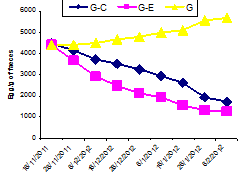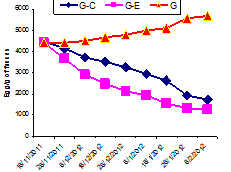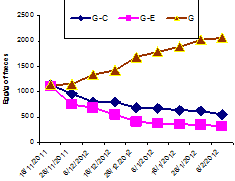 |
 |
|
Figure 1: Worm egg count (Strongyle) in growing
goats fed different foliages |
Figure2: Coccidia egg count in growing goats fed different foliages |
 |
|
|
Figure 3: Worm egg count (Cestode worm) in growing goats fed different foliages |
|
Livestock-Based Farming Systems, Renewable Resources and the Environment |
The study was carried out in GRRC. 30 growing goats (3.5 – 4 months of age) were allocated to 3 following treatments: G: Guinea grass alone (ad libitum); G-C: guinea grass ad libitum + cassava foliage (1.5% of LW DM basis); G-E: guinea grass ad libitum + Eupatorium odoratum foliage (1.5% of LW DM basis). The goats were not de-wormed before starting the experiment.
The research results indicate that: live weight gain (LWG) of goats was the highest in treatment G-C (53.9 g/head/ day), meanwhile, live weight gains of goats in treatments control (guinea alone) and G-E were 36 and 44,3g/ head/ day, respectively. However, the lowest parasite worm infection was G-E (Guinea grass + Eupatorium odoratum foliage).
 |
 |
|
Figure 1: Worm egg count (Strongyle) in growing
goats fed different foliages |
Figure2: Coccidia egg count in growing goats fed different foliages |
 |
|
|
Figure 3: Worm egg count (Cestode worm) in growing goats fed different foliages |